Wednesday, January 23, 2008, 06:28 PM
- Models
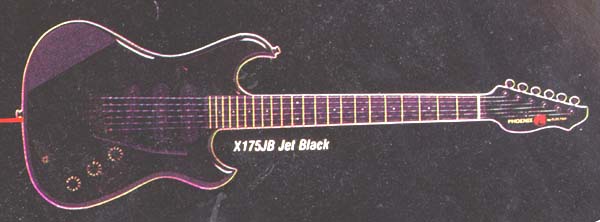
Bolt neck double cutaway with maple body, maple neck, rosewood fingerboard, black hardware, graphite nut and tekglide (vintage style) bridge, three single-coil pickups with three knobs (V-T-T) and 3-way selector knife switch.
The X175 was a replacement for the X140. By 1983 it was hard to sell a guitar without a tremolo bridge, and the X175 added that plus a strat-style 3-way knife switch instead of the Gibson-style 3-way of other models. Clearly this model was intended to be familiar to someone used to a Fender, and indeed it is the most strat-like of the line.
X175JB (S-S-S)(jet black)
permalink
| related link
Wednesday, January 23, 2008, 06:25 PM
- Models
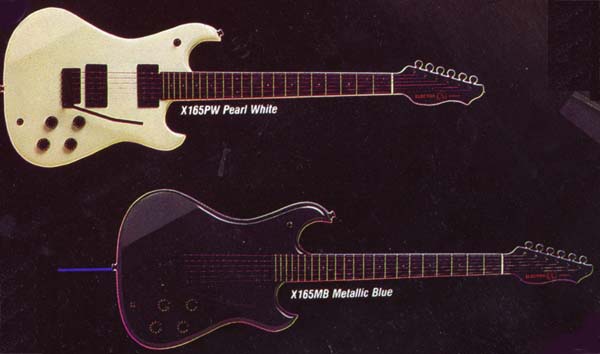
Bolt neck double cutaway with maple body, maple neck, rosewood fingerboard, black hardware, graphite nut and tekglide (vintage style) bridge, two humbuckers with four knobs (V-V-T-T) with pull-switches for coil tap and phase reverse.
X165PW (H-H)(pearl white)
X165MB (H-H)(metallic blue)
X165GR (H-H)(metallic olive green)
The X165 appeared in 1983 to replace the X130 with updated colors and a tremolo bridge. EVH was just appearing, and suddenly everyone wanted a guitar with a whammy bar, you couldn’t sell one without one, even though most people couldn’t do that much with it. The X165 was the first appearance of black hardware which became mostly standard throughout the line- very 80’s.
Wednesday, January 23, 2008, 06:22 PM
- Models
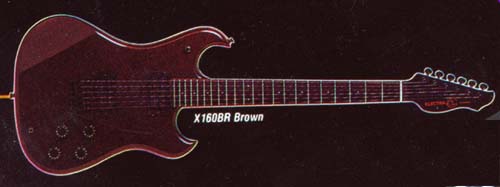
Bolt neck double cutaway with maple body, maple neck, rosewood fingerboard, black painted hardware, graphite nut and Tekglide (vintage style) bridge, two humbuckers with four knobs (V-V-T-T) with pull-switches for coil tap and phase reverse, active EQ.
X160BR (H-H, active EQ)(metallic brown)
The X160 is one of the rarer Electra Phoenixes, appearing only in 1983 at the end of the appearance of the X150 with which it shared active EQ. For a guitar with premium electronics, its brown metalflake finish is strangely subdued, one can only imagine it was intended for perhaps a jazz audience.
Was active EQ really a useful feature? Gibson had asked the same question with the Artist series, which it doomed by associating with the strange and unpopular RD series. It can be useful for some players- certainly a preamp is one way of shaping distortion. But for distortion you want to boost midtones, not high and low. Active EQ tends to be most useful for players who use clean tones, especially those who, like electric acoustic players, tend to be plugging into weird PA systems not designed for guitar, or in weird room situations.
Today we have to remember that making effect devices easily available to consumers was a fairly new innovation. There were some hairy fuzz pedals, and wahs, and giants like Hendrix and Page had them, but there was not the plethora of devices we have today. So having active EQ onboard, like the MPC guitars which carried onboard effects, was a really interesting experimental way to apply the electronics. It was a different direction than we see today, one which certainly put controls at the users’ fingertips. The question remains whether the average player really wants that much control. For the specialist, however, it offers premium performance.
Wednesday, January 23, 2008, 06:18 PM
- Models
Bolt neck double cutaway with maple body, maple neck, rosewood fingerboard, chrome hardware, brass nut and brass hardtail bridge, two humbuckers with four knobs (V-V-T-T) with pull-switches for coil tap and phase reverse.
X155 (H-H)(pearl white)
With so many Electra Phoenix models already available, it’s hard at first to see why the X155- a white two-pickup guitar- was so special, although the pearl white finish does have a gorgeous butter cream quality to it, which it shared with the X1PW which appeared at the same time. Like other special 82 models, the X135 and X145's, it carried a special plate on the headstock with an additional serial number whose significance is not known.
Above photos courtesy of Darren Costello.
The X155 was the first to carry many new features which would become standard for the entire Electra Phoenix line. Instead of a pickguard, it had pickups mounted flush with rings into a painted body. It used a four-knob arrangement (‘LP style’) to control the pickups, and had notched speed knobs instead of the brass knobs of previous models. And the body, instead of ash, was maple, whose hard resonance brings a bright singing tone.
In 1982 this was the time when New Wave and Punk were knocking at the door of mainstream awareness, driving out the last vestiges of seventies mellow. The X155 was a golden white harbringer of the styles that we recognize today as 80’s. From here on out, with only a few remaining exceptions, Electra Phoenixes had maple bodies in colors like white and red and black and green, with contrasting dark rosewood fingerboards, a clean look pioneered by the X155.
Wednesday, January 23, 2008, 06:15 PM
- Models
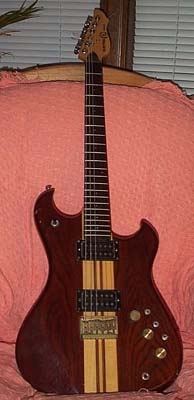
Bolt neck double cutaway with laminated ash, maple and walnut strip body, maple neck, chrome hardware, brass nut, brass hardtail bridge and dual humbuckers with toggle switches for coil tap and phase reverse, brass knobs for volume, preamp gain, and tone control.
When the Electra Phoenix first appeared in late 1980, there were the standard 2- and 3-pickup models with pickguards, and there was also a deluxe model with a body of dark brown ash with laminated strips of maple and walnut at the center. No doubt one of these would be ordered as premium display attractors but the lower priced models were what sold the most.
The laminated body follows the identical stripe pattern with many other Matsumoku-made guitars of the time, including the Aria Pro, Westone, Washburn and Skylark models.
Ironically, the laminated body is sometimes mistaken for an imitation of a neck-through guitar, which it is not. Excellent bolt-neck that it is, it need not pretend. Matsumoku had raised the art of making composite chunks of hardwood out of smaller to a fine degree, and these laminated bodies are made with all the care and attention of a flagship model.
In addition to its beautiful body, the X150 also sported a most exotic feature for the time: onboard active EQ. The third toggle switch turned on the EQ; when this was on the middle knob boosted the output, and the third knob would had a center detent and would boost treble when turned clockwise and bass when turned counterclockwise. When EQ was off, the tone knob worked like a conventional tone knob.
Was active EQ really a useful feature? Gibson had asked the same question with the Artist series, which it doomed by associating with the strange and unpopular RD series. It can be useful for some players- certainly a preamp is one way of shaping distortion. But for distortion you want to boost midtones, not high and low. Active EQ tends to be most useful for players who use clean tones, especially those who, like electric acoustic players, tend to be plugging into weird PA systems not designed for guitar, or in weird room situations.
Today we have to remember that making effect devices easily available to consumers was a fairly new innovation. There were some hairy fuzz pedals, and wahs, and giants like Hendrix and Page had them, but there was not the plethora of devices we have today. So having active EQ onboard, like the MPC guitars which carried onboard effects, was a really interesting experimental way to apply the electronics. It was a different direction than we see today, one which certainly put controls at the users’ fingertips. The question remains whether the average player really wants that much control.
The X150 is one of the finest of the Electra Phoenix family, its exotic wiring and excellent tone matched by the fact that flagship models, especially in the early 80’s, seemed to have been given extra hands-on attention, their lines and setup are generally especially good among the Phoenixes.
From the 1981 pricelist:
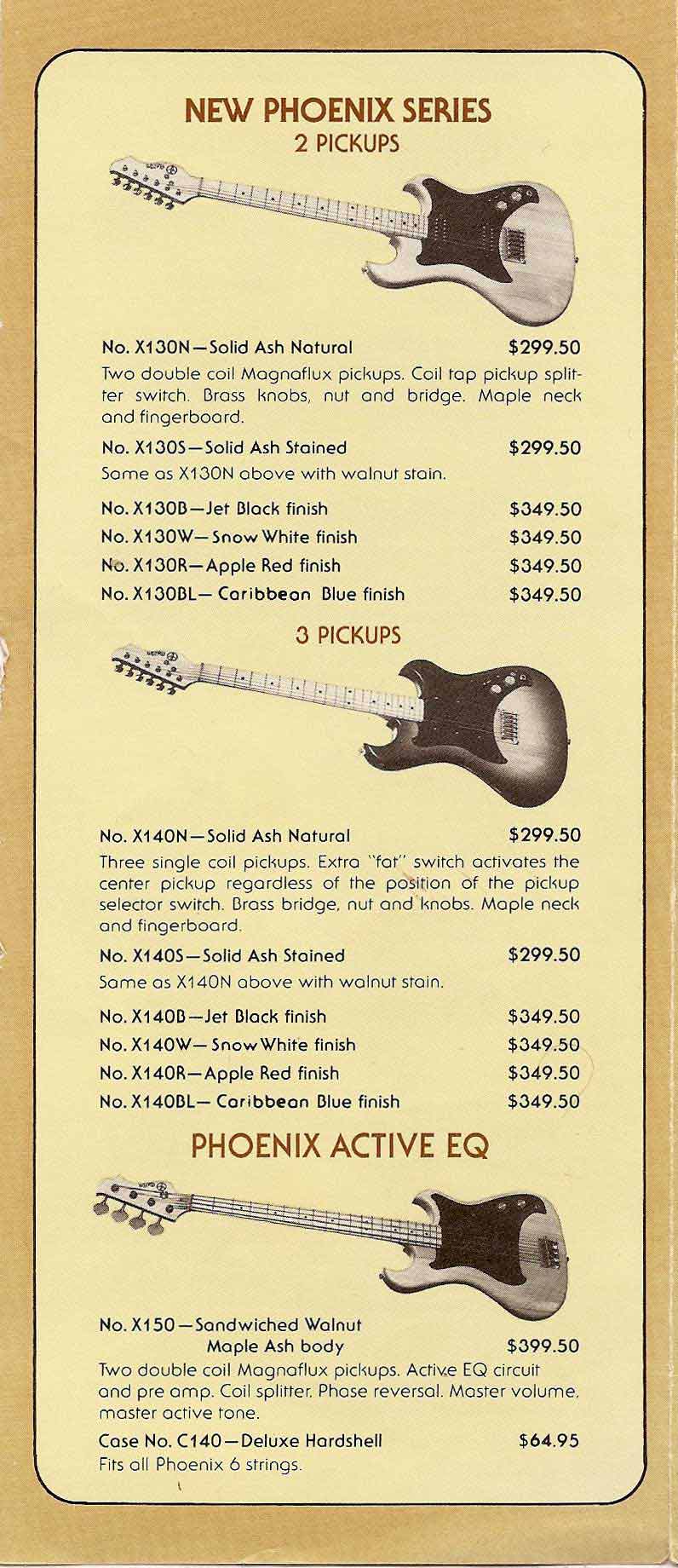
Back Next






